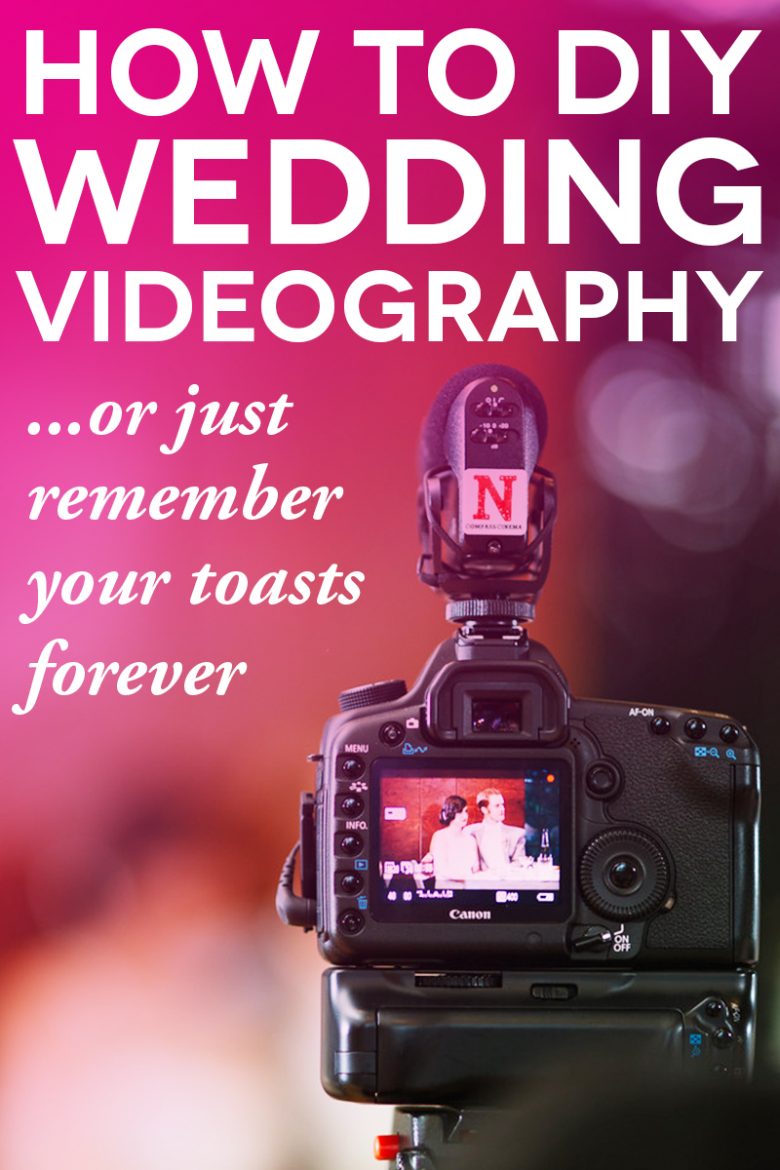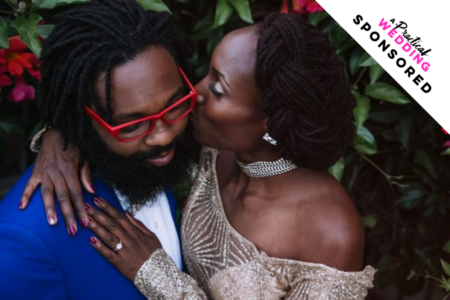
Wedding videography. It’s one of those things that you may realize you want (without video, toasts tend to be lost to the ages), but for lots of us, it’s just not in the budget to pay a professional. So, then what? Since there are video features on everything from your phone to some DSLRs these days, there must be a way to DIY wedding videography, right? Correct! You can even have pretty good video, or maybe even totally rad awesome video. Believe me—I got married long before I became a wedding photographer and videographer. We hired a professional photographer, but for some reason I decided that I myself would be the videographer. Um. Yeah.
LeahAndMark.com Get Married from LeahAndMark & Co. on Vimeo
That’s usually a recipe for disaster/no actual wedding video, but I proved it could be done! Still, I don’t recommend that for other people because it’s actually all kinds of bonkers. But! You can definitely have one of your friends be your videographer, even with no prior experience. All you need to do is follow these ridiculously simple DIY wedding videography tips.
1. Designate and empower a specific person to be your videographer
Let there be absolutely no confusion as to who will be doing the videography at your wedding. Even if you’re asking a friend or relative, you want to make sure to have a clear conversation with them about being your “videographer.” Your conversation should leave them feeling empowered to be filming during your wedding day as opposed to scared and pressured to make an award-winning movie. You can also split up duties among friends, and have one person film during the ceremony, then handing off duties to another person during the reception, etc. However you do it, the trick is to make your friend videographer feel special because they are.
2. Use whatever camera you can get your hands on
You can use smartphones, tablets, DSLRs, or even a regular video camcorder to film your wedding day. I’ve also seen people use the laptop cameras to video and live stream their ceremonies to six countries. You don’t need to purchase or rent an expensive professional camera. Sure it helps, but if you’re going to spend all that money, then why don’t you just hire a professional videographer? If it’s truly more important that your wedding day is filmed, period, than stop worrying about whether or not it’s recorded in HD quality suitable for Blu-ray discs burning and playback on the largest television ever created.
3. Use a tripod
A tripod is an absolute must-have piece of equipment no matter what camera you are using to film your wedding day (seriously, this might be the most important of our wedding videography tips). One of the biggest things that ruins handheld video is that it’s handheld. Basically—it’s shaky, unstable, and makes everyone watching it get motion sickness. Any video that is going to be longer than forty-five seconds should be done with a tripod. A cheap five-foot tripod is all you need and it’ll make your video 156 percent more watchable. If you’re using a smartphone to film then you’ll also need a proper mount, but it’s definitely worth it. (See equipment notes at the end of the post.) Don’t rely on your friend holding their arms up with their phone for seventeen minutes from their seat in the third row behind all the tall people.
4. Move slowly or not at all
Your friend that will be doing the video needs to know that the ultimate goal is to have steady, usable footage. They’re not responsible for making an artful or cinematic movie of your wedding day. They just need to put the camera in a spot that captures what’s going on and make sure it’s recording. Unless they have experience with video camera work, then they should move the camera as little as possible when it’s filming. Sure if the subject moves out of the frame, follow them or zoom out—slooooowwwwwly—but the overall goal is to not move the camera at all. So no moving back and forth between people speaking and no attempts at anything resembling an action shot. Their filming should feel like it’s “just the facts.”
5. Communicate with your photographer
Since your friend that’s doing the video won’t be moving that much, they probably won’t get in the way of your photographer. If you’ve hired a professional photographer, then they will most likely be happy to give tips on where the best spot is for your friend to set up their camera, because photographers are divas and they think they know everything. Just kidding! (Well, kind of and not really.) This will also ensure that your photographer knows to generally stay out of the video camera’s line of sight. Ideally your photographer will work with your friend doing the video as if they’re team—because they are!
6. Be close enough to hear
The only thing worse than having shaky handheld video is being unable to hear anything being said. We’ll watch bad video with good sound, but we won’t watch good video with terrible sound. The easiest way to make sure your camera is picking up sound is to position it close enough that you can hear the person speaking. Unless everyone is talking into a microphone that’s blasting through speakers, don’t position the camera far away from the action. If you can hear the person well then the camera probably can too, and that’s how close you need to position your camera on it’s tripod.
7. Make complete recordings
Hit the record button at the beginning of the ceremony and don’t hit stop until long after the ceremony is over. Hit the record button before the first dance starts and don’t hit stop until thirty seconds after the first dance is over. Hit the record button before… well you get the idea. What you want are complete clips of each event from start to finish. No cuts in the middle and no missing sections. Even if the camera has to move to a better spot, just keep recording. One continuous take even with a small section of blurry movement is better than possibly missing something important. It’ll also make the editing process approximately 143 percent easier.
8. Editing can be positively easy
If your friend made complete recordings of each exciting event at your wedding then the editing process becomes super, super, super easy. It’s ridiculously easy. Ceremony footage? You just need to decide when you want it to fade in to start, and then fade out to end. Speeches and cake cutting? When do you want each clip to start and stop? See? Since it’s just one clip you don’t need to line up audio and overlap multiple clips together to make a usable shot. It’s basically done and you just need to decide when you want the video to start and end. If you’ve used Snapchat, or Vine, or Instagram then you’re already doing this type of video editing.
Why? Because, Love
While you might or might not want your ceremony recorded, there are really good reasons to get at least a little bit of video at your wedding. I’ve heard some amazing speeches of love and joy at weddings from family members, some that are no longer with us. There are some things that photography cannot record the same way video footage preserves a moment for playback. So if you want video, make a plan. Pricey artistic wedding videos are great, but remembering that tearful speak forever… that’s priceless (and luckily, basically free).
When it comes to gear, simple is always better. Here are a few basics:
- A simple tripod that’s at least five feet tall
- A cell phone tripod mount
- A video light (or even a strong wide-beam flashlight) if things are going to get dark—or just make sure everyone stands in a well-lit spot and not a dark corner.
- Extra batteries or mobile battery pack
- Windows Movie Maker or iMovie for simple video editing are free and easy to use. You can even make DVDs from them.






